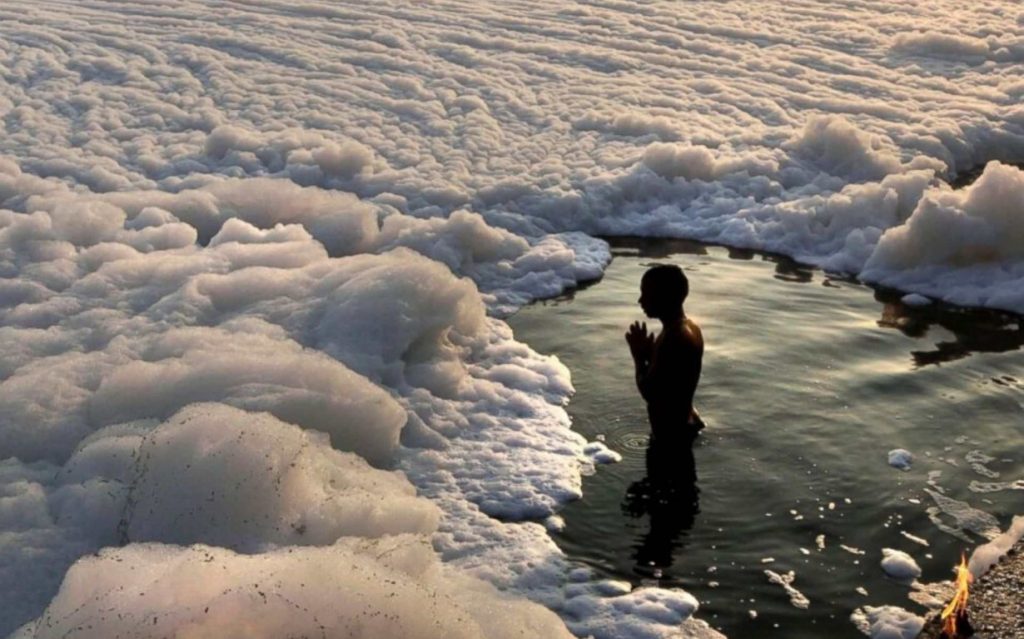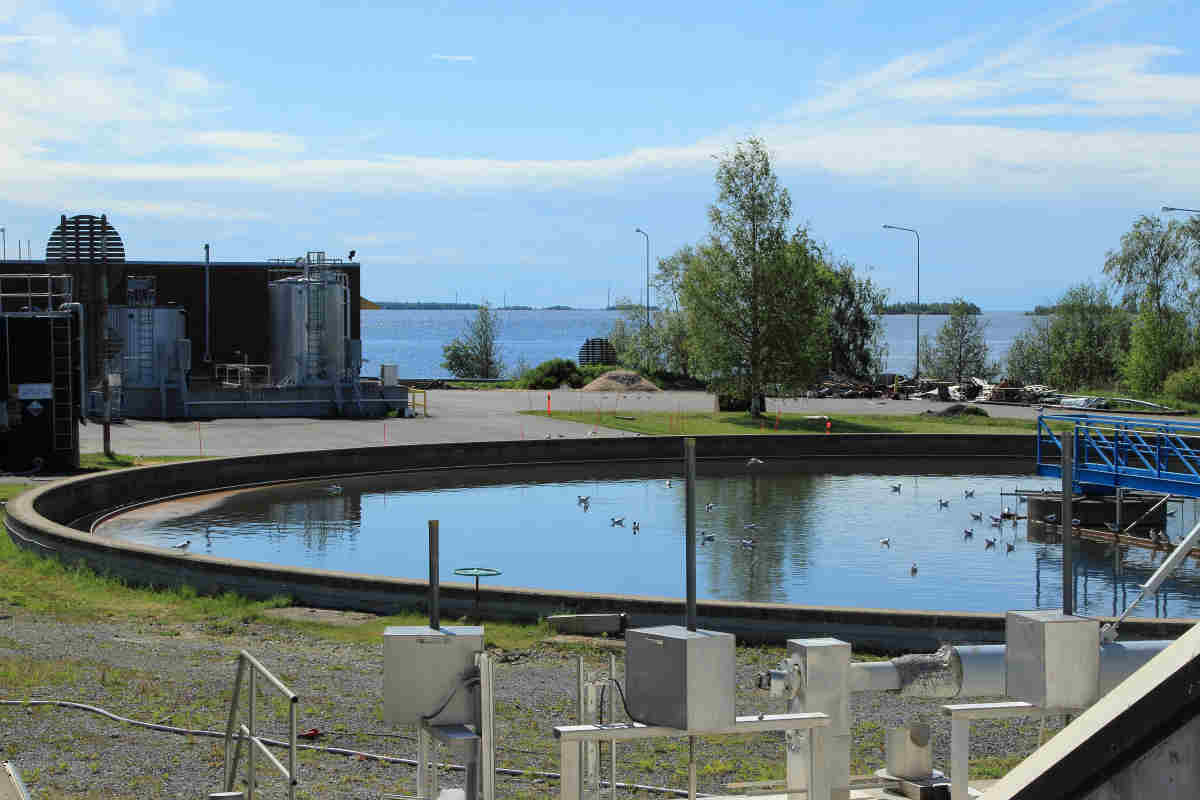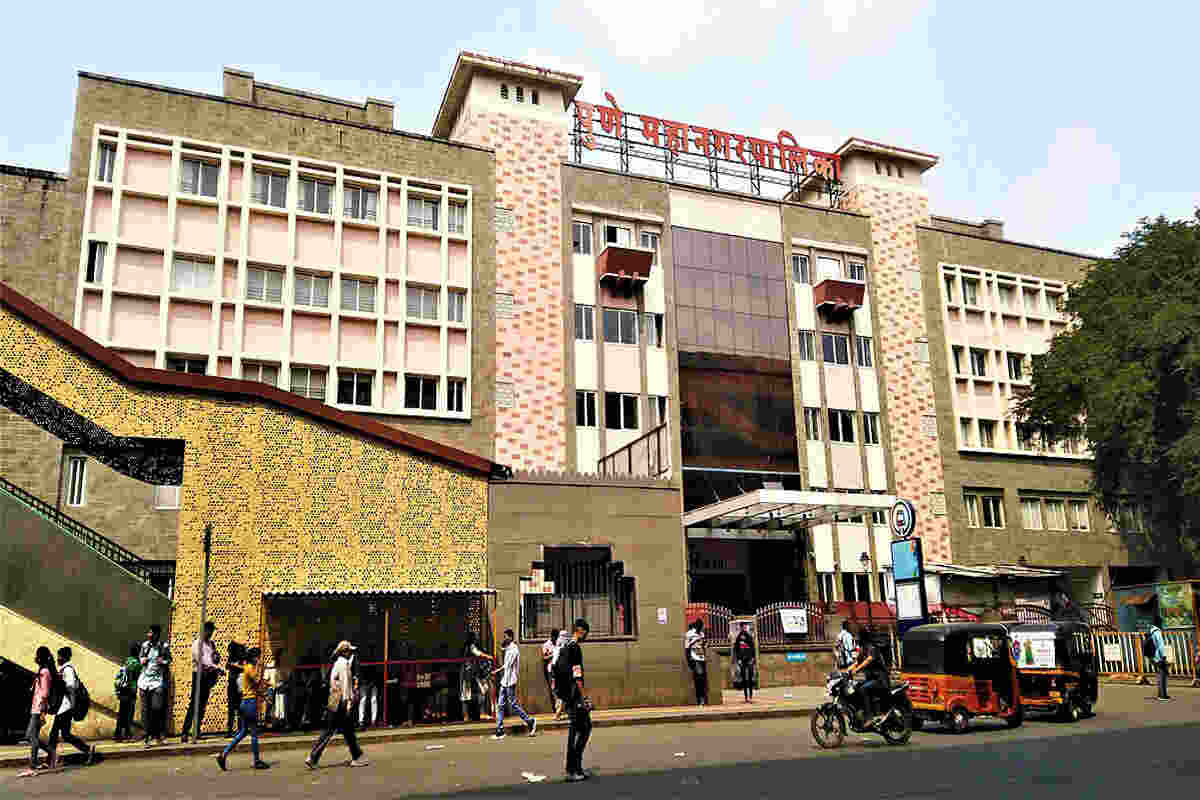
Yamuna River Pollution And Sustainable Solutions For The Future
About 57 million people depend on Yamuna waters as it accounts for more than 70% of Delhi’s water supplies, but today it is also referred to as ‘Delhi’s dying holy river’.
Yamuna is the second largest tributary of River Ganga and the longest tributary of India, it originates from Yamunotri glacier in Uttarakhand and flows across seven states and merges with the river Ganga at Sangam in Prayagraj, Uttar Pradesh.
- Religious Significance: Yamuna is worshipped in Hinduism as the ‘Goddess Yamuna’ and as per Hindu mythology is the daughter of the Sun and sister of the Yama the ‘God of Death’. It is common practice for people to bathe in the sacred waters to rid oneself of sins and the last rites of the dead are also performed at its banks.
- Socioeconomic Significance: It helps create the highly fertile alluvial Yamuna- in the Indo-Gangetic plain. Nearly 57 million people depend on the Yamuna’s waters. With an annual flow of about 10,000 cubic billion metres, the river accounts for more than 70% of Delhi’s water supply.
POLLUTION
Long ago, the waters of Yamuna were pristine blue but today the Yamuna is considered to be one of the severely polluted rivers in the world. The Yamuna is particularly polluted downstream of New Delhi, the capital of India, which dumps about 58% of its waste into the river.
The most pollution comes from Wazirabad, from where Yamuna enters Delhi.
Main Sources of Pollution
- Domestic Sources
According to a report submitted by the Delhi Pollution Control Committee and the Central Pollution Control Board (CPCB) to the Yamuna Pollution Control Committee, at least 90% of domestic wastewater in the city flows into the Yamuna.
The wastewater mainly comes from household activities hence the presence of high content of detergent, laundry chemicals, and phosphate compounds.
Samples collected were found to have phosphate concentration of 0.51 mg/litre, which is higher than the normal range of 0.005 to 0.05mg/litres.
This abundance of phosphate formed layers of toxic froth covering the rivers.
- Industrial heavy metal contamination
The catchment area of River Yamuna in Delhi is highly urbanized and is networked with several drains. Najafgarh and Shahdara drains are the major drains that discharge a heavy load of pollutants into the river.
Rapid urbanization and population growth results in industrialization pose a major threat of heavy metal pollution for nearby water bodies. The water quality monitoring of River Yamuna has indicated a significant presence of several heavy metals in its water.
Among the heavy metals investigated in the River Yamuna water, Iron (Fe) was found to be most abundant and even exceeding the limit.
High amounts of heavy metals in water can cause several health effects such as reduced growth and development, cancer, organ damage, nervous system damage, etc.
- Untreated Sewage
More than 800 million litres of largely untreated sewage is pumped in the Yamuna each day. Another 44 million litres of industrial effluents are also discharged daily into the river.
Sewage that is treated before being released into the river accounts for only 35% of the total estimated sewage discharge.
According to the Central Pollution Board, the water contains a concentration of 1.1 billion fecal coliform bacteria per 100 milliliters of water. The standard for bathing is 500 coliform bacteria per 100 milliliters.
Although Sewage treatment plants (STPs) have been constructed in various parts of Delhi, the treated, or partially treated sewage from these STPs is continuously being discharged directly or through the carrier drains into the river.
Many times untreated sewage goes directly into the river at few locations due to non-operational STPs caused by power failures, mechanical problems or maintenance issues, which further deteriorate water quality issues.
- Idol Immersion leading to increased toxicity
Immersion of idols during festivals with cheap lead and chrome paints and plaster of paris and puja articles such as polythene bags, foam cut-outs, flowers, food offerings, decorations, metal polish, plastic sheets, cosmetic items all are a cause for concern for the river’s quality.
Post-immersion, the Central Pollution Control Board (CPCB) found that the level of heavy metals such as chromium and iron increased significantly.
Chromium increased 11 times from the permissible limit of 0.05mg/L, while iron concentration increased 71 times from the 0.3 mg/L limit.
If the water is not treated, it will increase the chance of toxins entering the food chain through vegetables grown on the floodplains. The toxicity of heavy metals can damage the brain, lungs, kidney, liver, other vital organs functions and alter blood composition.
- Plastic Pollution
In Agra, the Yamuna has been choked by intense plastic pollution. After the 2017 ban on single-use plastics, there has still been rampant use of plastics which is evident by the production of plastic.
According to records, Delhi produces 2,51,674 tonnes of plastic each year — 50% of which is single-use. That’s roughly 63,000 elephants worth of plastic.
Along the river, anything from flip-flops to paper products lay in piles every few feet and a lot of plastic bags, even recyclable ones, end up in the river.
Dr Anil Kumar, director at the state environment department, said plastics enter the river mostly through open drains in which people dispose of their waste.
CORONAVIRUS AND ITS EFFECTS ON YAMUNA
- With industries shut due to the novel coronavirus disease (COVID-19) lockdown, national capital city’s residents have been sharing photographs of a ‘cleaner Yamuna’.
- However, according to reports, industries make only 10 to 20% of pollution load and the majority of the pollution load comes from domestic sewage, which has not seen any decline as the household waste has continued.
- However, there is no real-time or comparative data to measure the impact of lockdown on pollution in Yamuna so far.
PROJECTS AND PLANS FOR YAMUNA
- Yamuna Action Plan
It is one of the largest river restoration projects in India which is a bilateral project between the Government of India and Japan. It is being executed by the National River Conservation Directorate and the Ministry of Environment and Forests and the Government of India.
The project is divided into 3 parts:
- Yamuna Action Plan I (YAP I) – 1993 – 2002, 2002 – 2003 (Extended Phase)
The plans were carried out by the National River Conservation Directorate (NRCD), Ministry of Environment in collaboration with various State Department. The plan focused on two types of actions which are Sewerage and non-sewerage facilities.
Sewerage: construction of 29 STPs 58 pumping stations and 179 km of sewers was proposed.
Non-sewerage: 1282 public toilet complexes, 96 crematoria, Riverfront development, plantation and public awareness and participation were proposed. A study on river pollution to estimate future pollution loads of the river Yamuna from different sources. The total sewage treatment capacity created under YAP I was 750MLD.
- Yamuna Action Plan II (YAP II) – 2004 – 2011
YAP II was mostly to undertake non-sewerage part of the objectives.
The total STP capacity sanctioned under YAP II was 189 MLD. The total budget sanctioned: INR. 6.24 billion. There was an emphasis on Public Participation & Awareness, Public Relations and Institutional Strengthening & Capacity Building of MCD. A Master Plan and Feasibility Study was also carried out.
Various Pilot projects included Dairy Farm Waste Management, Dhobighat Sudhar Yojna, Slaughterhouse Modernisation and Waste Management, Antim Niwas Sudhar Yojna and Slum Rehabilitation Study.
- Yamuna Action Plan Phase III – 2018 onwards
11 Projects under National Mission for Clean Ganga (NMCG) have been planned to conserve River Yamuna in Delhi including rehabilitation of sewers, rehabilitation of Rising mains, Tertiary Treatment Plants and Sewerage projects in four packages of Kondli (K1, K2, K3, K4), three packages of Rithala (R1, R2, R3) and Okhla Zone (O).
- Yamuna Purification Drive, 2018
Organized by the Public Health Department and covers 15 towns including Gurgaon, Faridabad, Yamuna Nagar, Karnal, Panipat, and Sonepat. Its objectives are to control the discharge of raw sewage into the river.
Initiative that has been done are:
- Eleven treatment plants are being installed along the 83-km-long sewer line.
- A treatment plant that can treat 30 million liters a day has been installed in Gurgaon which will help reduce the level of pollution from 200 mg a liter to 30 mg a liter, before it enters the Yamuna.
- A 5.8-km-long sewer line has been laid in the city to collect the polluted water at the treatment plant.
COMMUNITY INITIATIVES
- Yamuna Foundation for Blue Water Inc.
Started in 2000 and the objective is to clean the pollution in the Yamuna River throughout its course and to create a better ecosystem in New Delhi. On World Water Day, 2010, local team members, students, and activists in Agra, Hyderabad, and Delhi, India, along with Wuhan, China led several watershed cleanup projects.
- ‘Maa Shri Yamuna Seva Samiti’ or Friends of Yamuna
Volunteer group started by newspaper hawker Ashok Upadhyay to do his bit in protecting the river from further pollution.
On the last Sunday of every month, Upadhyay comes to the Chhath steps of the river near to clear the waste accumulated on the banks. He is joined by about 100 other newspaper hawkers of the city who have taken upon themselves to be the change that they want to see.
SUSTAINABLE SOLUTIONS (SOCIO, ECONOMIC, ENVIRONMENTAL)
Creating a project that balances the social, environmental, and economic interests of a community is important to achieve sustainability. When a project is planned in consideration of all these aspects, it will create a long-lasting program that benefits everyone.
What can be done at the administration level
- Develop more public toilets and crematoria to reduce the sewage waste into the river.
- Educational programs to increase awareness encouraging people to use biodegradable paints for painting idols and stop dumping wastes in the rivers is needed.
- Stringent Implementation of regulation for industries and hospitals not to dump waste in the river
- Upgradation of existing sewage treatment plants (STPs) that don’t comply with standards.
- Integration of water management by linking the private sector, local communities and NGOs to ensure an effective and efficient allocation and use of water for all.
- New strategies for the existing water treatment such as automated river quality monitoring.
- Develop parks with fountains or grassy lands, pools, plantations, etc., along the riverbanks to provide opportunities for water to undergo artificial aeration that leads to self-purification of the river.
- Full and participatory environmental impact assessments should be ensured for all projects.
What can be done at the Community Level
- The locals can report ground results and activities on a regular basis to help authorities keep check on the effluent disposal by the industries.
- Train and educate people about ensuring proper maintenance of the sewage system and waste disposal methods.
- Create a waste management system that can help the community make a livelihood for themselves in the form of recycling and upcycling the wastes.
- Apply rainwater harvesting to meet water requirements throughout the year that is uncontaminated for domestic and other needs.
- Improving the community’s literacy rate (taken as a proxy for awareness). A study has shown that a significant positive relationship is found between the rate of increase in literacy level in a district and the water quality in rivers flowing through the district.
- Community can use more environmentally friendly idols alternatives that use organic materials.
THE EARTH5R CIRCULAR ECONOMY BASED SOLUTIONS
Earth5R works with citizens to tackle sustainability issues that affect their local ecosystem. One of the initiatives that Earth5R has done is in the Yamuna River.
15-20 volunteers from Earth5R went to the Yamuna River where they were shocked to find how utterly lifeless the river looked due to the pollution. The water was dark and there was trash everywhere. It was clear that their waste management strategies (or lack thereof) have not been successful.
The volunteers spread out and cleaned up as much of the area that they could. As a result, about 2-3 full bags of plastic and other rubbish were collected from just that small area alone. The waste was then given to the ragpicker who then is able to recycle it and earn some livelihood.
This is one example of a circular economy model. As it brought social, economic and environmental impacts.
- Social : A better system of clean-up activity that also helps the local rag pickers instead of just leaving the garbage on the bank.
- Economic : Providing a livelihood to the local rag pickers by giving them the opportunity to recycle the collected waste.
- Environmental : A cleaner river and a better waste management.
By establishing circular economy based programs that are an alternative to a traditional linear economy (make, use, dispose) and have active collaborations with the local community, local problems like bad waste management can be turned into opportunities for the local community.
Reach out to Earth5R to know more about solving environmental issues by creating circular economy based sustainability projects.
ABOUT EARTH5R
Earth5R is an environmental organization from India with its head office at Mumbai. It works with the NGO sector, Companies and helps them conduct environmental corporate social responsibility (CSR) programs across India. Earth5R specializes in circular economy based projects. Earth5R also offers short term and long term environmental courses.
Earth5R’s Global Sustainability Hub is a cross-sector and cross-country collaboration in pursuit of UN Sustainable Development Goals. It is an excellent opportunity for governments and the private sector to engage with communities, use Sustainability-based models to drive economic changes and create social and environmental impact
To read more hot environmental news and articles like this, download the Earth5R Environmental App.
The Earth5R Environmental app is the first global citizen-driven environmental platform.
The Earth5R app is an all-in-one sustainability platform for learning, connecting, acting, and growing your sustainability portfolio.
The new “Instagram of sustainability.” The Earth5R Environmental app is now available in 140 countries.
Earth5R has been named by UNESCO as one of the top 100 global environmental initiatives and showcased as “UNESCO Green Citizens.
Reported by P. Tewary, edited by Shafa Azzahra



